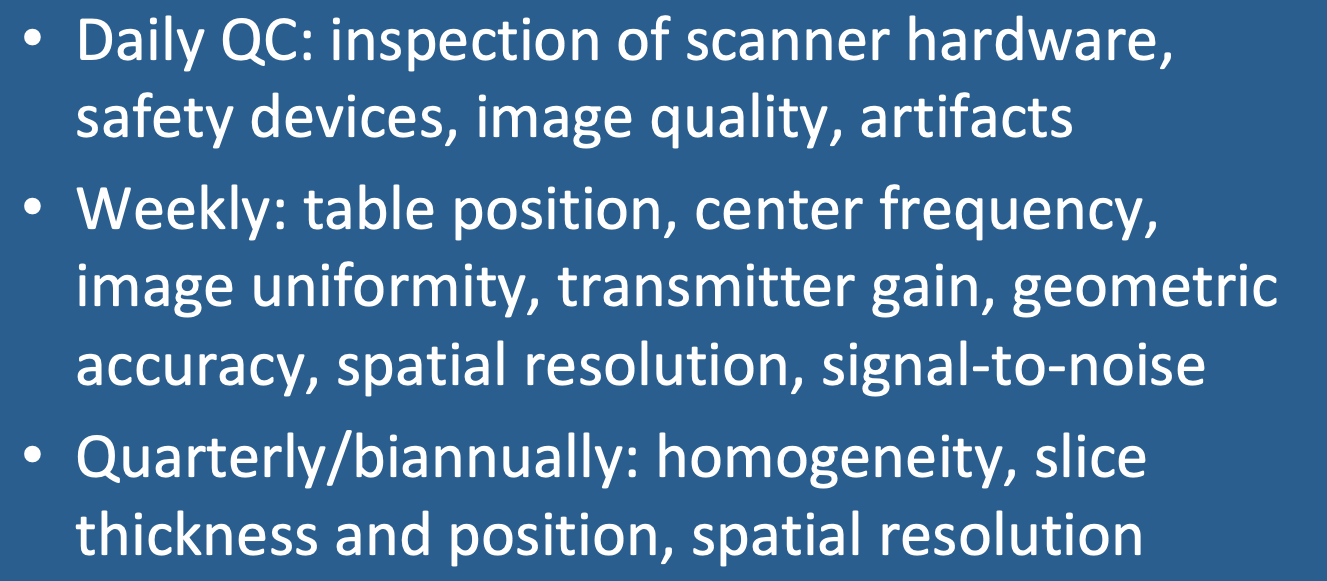Continuous quality control (QC) is mandatory whether or not an MR facility decides to become accredited. Most of the routine (daily/weekly) tests are performed by an MR technologist. More detailed calibration and testing on a semiannual or yearly basis requires a skilled service engineer or medical physicist.
Daily QC activities include visual inspection of all scanner hardware, the function of safety and communication devices, and general assessment of image quality including identification of artifacts. On at least a weekly basis, a special MR phantom is placed in the scanner and various measurements are made and recorded. Such measurements include landmark accuracy (table position), center frequency, image uniformity, transmitter gain or attenuation, geometric distortion, spatial resolution, artifact evaluation, and signal-to-noise ratio. Maximum acceptable variances for each measurement are established (e.g., table position < ±1 mm, center frequency < ±1 ppm). These are recorded in a log as shown below:
Daily QC activities include visual inspection of all scanner hardware, the function of safety and communication devices, and general assessment of image quality including identification of artifacts. On at least a weekly basis, a special MR phantom is placed in the scanner and various measurements are made and recorded. Such measurements include landmark accuracy (table position), center frequency, image uniformity, transmitter gain or attenuation, geometric distortion, spatial resolution, artifact evaluation, and signal-to-noise ratio. Maximum acceptable variances for each measurement are established (e.g., table position < ±1 mm, center frequency < ±1 ppm). These are recorded in a log as shown below:
Major MRI vendors offer software packages that perform automated daily quality assurance measurements using their own phantoms. GE’s Daily Automated Quality Assurance (DAQA) system acquires 4 mulitplanar images on a test phantom, then calculates and tracks center frequency, transmit gain, SNR, ghosting, and geometric accuracy.
Upon delivery of a new scanner and every 6-12 months a more detailed Image quality assessment by a trained physicist or engineer should be performed. These tests include measurement of magnetic field homogeneity, slice position accuracy, slice thickness accuracy, spatial resolution tests, artifact analysis, and RF coil calibration. Additional tests may be added depending on the site's use of specialty applications (e.g. spectroscopy, diffusion tensor imaging, fMRI). A sample completed MR physicist form from my own institution for acceptance testing of our Siemens Skyra in 2017 can be viewed here.
Deviations from established thresholds must be documented and corrective action taken where
appropriate.
Deviations from established thresholds must be documented and corrective action taken where
appropriate.
Advanced Discussion (show/hide)»
No supplementary material yet. Check back soon!
References
American Association of Physicists in Medicine (AAPM). Report No.100. Acceptance testing and quality assurance procedures for magnetic resonance imaging facilities. 2010.
American College of Radiology. Phantom test guidance for use of the large MRI phantom for the ACR accreditation program, 2018. (This document provides step-by-step instructions on exactly how to perform the various QC measurements listed above).
American Association of Physicists in Medicine (AAPM). Report No.100. Acceptance testing and quality assurance procedures for magnetic resonance imaging facilities. 2010.
American College of Radiology. Phantom test guidance for use of the large MRI phantom for the ACR accreditation program, 2018. (This document provides step-by-step instructions on exactly how to perform the various QC measurements listed above).
Related Questions
Please explain how and why the center frequency must be adjusted.
What is the purpose of adjusting the transmitter gain/attenuation?
Why is receiver gain adjustment necessary? What happens if it is set incorrectly?
Please explain how and why the center frequency must be adjusted.
What is the purpose of adjusting the transmitter gain/attenuation?
Why is receiver gain adjustment necessary? What happens if it is set incorrectly?

